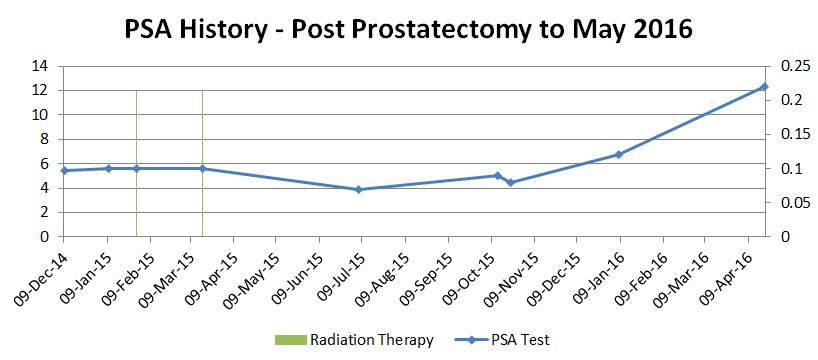What the heck!!
The PSA is supposed to go down after surgery and radiation – way down.
Well, it did at first – from 9.1 before surgery to .097 after the radical prostatectomy on October 7, 2014 – that was a great drop.
The best outcome, I am told, is an ‘undetectable’ reading where the PSA value is at the measurement noise level – maybe around .03.
That was predictably not the case for me since my biopsy results were poor (Gleason Score of 9) and my pathology after the prostatectomy indicated cancer cells outside the prostate core and in both seminal vesicles.
Thus the reason for undertaking radiation therapy to zap anything that might be still hanging around the pelvic area.
I opted out of adjutant (as an ‘addon’ to the primary prostatectomy) hormone therapy since there was no convincing scientific evidence to indicate any better result than without it.
As you see in the graph below, the PSA went down slightly in the year after radiation therapy (February/March 2015) – that was good!

But, the PSA definitely seems to be on the rise a bit – 0.08 to 0.12 from November 2015 to January 2016 (50%), and 0.12 to 0.22 from February to April 2016 (another 83%).
We are dealing with pretty low values here in absolute terms.
Check out the graph below on a higher scale, measuring my PSA over the past 10 years. The current absolute PSA looks pretty good from this perspective!
This graph shows the biopsies (first two verticle lines – orange and blue), the prostatectomy (red verticle line), and the radiation therapy envelope (two green verticle lines). It also includes the periods before the prostatectomy when Finasteride appeared to lower the PSA, and Dutosteride seemed to have no positive affect as the PSA maxed out at 9.1.

“This is not the end of the world”, says Dr. Morash.

But, this failure of the PSA to trend downwards to an undetectable level may be an indication of residual cancer within and/or outside the prostate cavity. Inside the prostate cavity is unlikely due to the aggressive surgery and radiation therapy carried out. It is more probable that some microscopic cancer cells have migrated outside of the prostate area.
So, what next, ‘doc’ ?
“We’ll first have a look at the prostate area with an MRI – to see if there is any evidence of cancer remnants there”.
(check out my article on the MRI procedure that followed on the 2nd of May, 2016 – Raja and Josiane did a spectacular job of photography – it was a blast! – well, not quite an explosion, but pretty loud – it was like being in a submarine during a depth charge attack!)
“Then, we’ll just keep monitoring your PSA.”
In the meantime, I have decided to go on the attack and see if I can build up my immune defenses and beat these little microscopic ‘interlopers’ with better ‘targeted’ nutrition and lifestyle.

Yum yum !!


